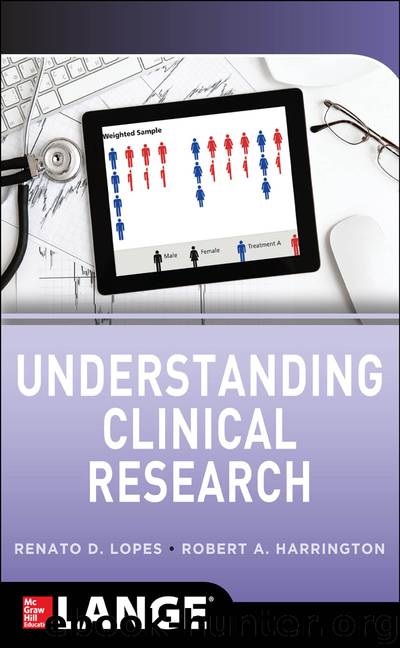Understanding Clinical Research by Renato D. Lopes

Author:Renato D. Lopes
Language: eng
Format: epub
Publisher: McGraw-Hill Education
Published: 2013-03-20T16:00:00+00:00
CHAPTER NINE
Challenges of Clinical Trials in Pediatrics
Kevin N. Turner and P. Brian Smith
HOUSTON, WE HAVE A PROBLEM
Janna was a 3-month-old baby who had survived neonatal cardiac surgery with a good prognosis. Not unlike other young children, Janna suffered from gastroesophageal reflux and was receiving cisapride. One morning, she was noted to be fussy while in her swing chair and, within 10 minutes, became unresponsive.
Cisapride was a medication approved by the US Food and Drug Administration (FDA) in 1993 for nighttime heartburn in adults. It was never shown to be effective or safe in children under the age of 16 and therefore had no FDA approval for use in this population (1,2). However, cisapride quickly found a market treating a common neonatal problem, gastroesophageal reflux (GER). There was a flavored syrup formulation that was labeled for use in geriatrics, but 90% of its sales were for use in pediatric patients (3). Hospitalized preterm infants also receive medications for symptoms thought to be associated with GER, including apnea, bradycardia, coughing, choking, and cyanosis (4,5). By 1998, more than 19% of infants in neonatal intensive care units (NICUs) in the United States were receiving cisapride (4).
In 1995, a case report had been published of a particular arrhythmia, prolonged QT interval, in a 64-year-old patient taking high-dose cisapride (6). QT prolongation, although not independently dangerous, can lead to the fatal arrhythmia torsades de pointes, especially during episodes of bradycardia. Additionally, erythromycin, commonly used in infants, was found to carry a particularly high risk of fatal arrhythmia when coadministered with cisapride, both by inhibiting its metabolism and by exaggerating ion channel disturbances that cause QT changes (4). By 2000, after 80 deaths and 341 serious adverse events had been reported, mostly in children, cisapride was pulled from general use in the US market (4,6,7).
Cisapride is just one example of many therapeutics often used in children despite a paucity of safety, dosing, and efficacy data. Trimethoprim/sulfamethoxazole, an antibiotic that was deemed safe to use in children, is another. In the 1950s, physicians recognized that infants who received the antibiotic prophylactically had a much higher incidence of kernicterus, a permanent neurological complication of hyperbilirubinemia. Transient hyperbilirubinemia is present in every newborn, and kernicterus is a complication observed almost exclusively in this population. Therefore, kernicterus had not previously been described during the use of trimethoprim/sulfamethoxazole in adults. After this association was noted, studies in animals found that trimethoprim/sulfamethoxazole displaced bilirubin from albumin, increasing the risk of kernicterus in newborns (8).
In the late 1990s, premature infants often received prophylactic steroids to prevent chronic lung disease. Although steroids never received FDA approval for this indication, several randomized trials did show short-term benefits (9,10). When long-term neurodevelopment was examined, however, steroids were associated with a significant increase in the risk of cerebral palsy (11,12).
In 1963, Dr. Harry Shirkey coined the term “therapeutic orphans” to describe children, owing to the lack of active research dedicated to defining the optimal dosing, safety, and efficacy of therapeutics in this population (13). Historically, up to 75% of drugs have had insufficient labeling for pediatric safety, efficacy, and dosing.
Download
This site does not store any files on its server. We only index and link to content provided by other sites. Please contact the content providers to delete copyright contents if any and email us, we'll remove relevant links or contents immediately.
| Administration & Medicine Economics | Allied Health Professions |
| Basic Sciences | Dentistry |
| History | Medical Informatics |
| Medicine | Nursing |
| Pharmacology | Psychology |
| Research | Veterinary Medicine |
Periodization Training for Sports by Tudor Bompa(8170)
Why We Sleep: Unlocking the Power of Sleep and Dreams by Matthew Walker(6618)
Paper Towns by Green John(5087)
The Immortal Life of Henrietta Lacks by Rebecca Skloot(4525)
The Sports Rules Book by Human Kinetics(4290)
Dynamic Alignment Through Imagery by Eric Franklin(4116)
ACSM's Complete Guide to Fitness & Health by ACSM(3989)
Kaplan MCAT Organic Chemistry Review: Created for MCAT 2015 (Kaplan Test Prep) by Kaplan(3939)
Introduction to Kinesiology by Shirl J. Hoffman(3722)
Livewired by David Eagleman(3682)
The Death of the Heart by Elizabeth Bowen(3551)
The River of Consciousness by Oliver Sacks(3536)
Alchemy and Alchemists by C. J. S. Thompson(3448)
Bad Pharma by Ben Goldacre(3355)
Descartes' Error by Antonio Damasio(3229)
The Emperor of All Maladies: A Biography of Cancer by Siddhartha Mukherjee(3064)
The Gene: An Intimate History by Siddhartha Mukherjee(3047)
The Fate of Rome: Climate, Disease, and the End of an Empire (The Princeton History of the Ancient World) by Kyle Harper(3003)
Kaplan MCAT Behavioral Sciences Review: Created for MCAT 2015 (Kaplan Test Prep) by Kaplan(2936)
